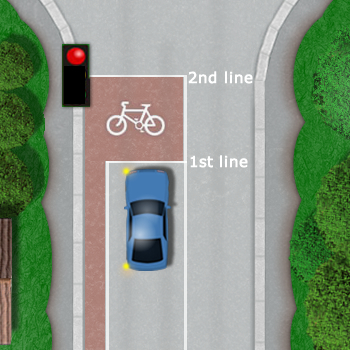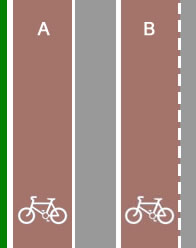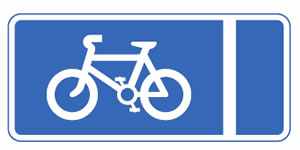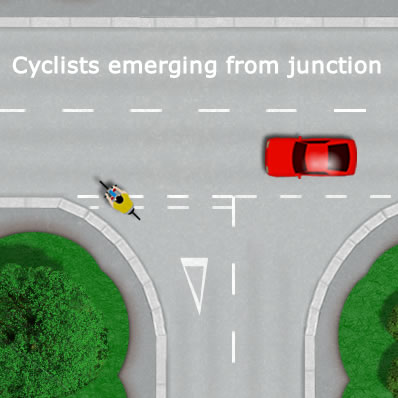With the ever increasing costs of running a car, more individuals are using bicycles as a cheaper and healthier mode of transport.
The increase in cyclists on the roads inevitably leads to an increase in accidents between vehicles and cyclists. Based on official accident statistics for the year 2014, there were 3,401 seriously injured cyclists and 113 fatalities.
Driving examiners are aware of this and can be particularly strict on how learners deal with cyclists during a driving test. As a high number of driving tests are failed due to learners driving inappropriately or unsafely around cyclists, this section deals with the correct method of driving among cyclists.
Whilst this guide may seem a little harsh on the inappropriate riding of some cyclists, it’s essential that a learner driver is taught not only how to correctly drive in and around cyclists, but to also be prepared for those few unpredictable and potentially dangerous cyclists. Whilst motorists can be equally inconsiderate and dangerous as a cyclists, this article focuses on cyclists only.
Advanced stop lines
Advanced stop lines or cyclists waiting areas are often located in busy areas at light controlled junctions. Often incorporated into the driving test, all vehicles including motorcycles should keep the cyclist waiting area clear by stopping just before the first white line.

If your vehicle has passed over the first solid white line which can be common in slow moving traffic and the traffic lights change to red, you must stop before the second white line and wait in the cyclist waiting area. Although stopping in the cyclist waiting box is the correct procedure to avoid running a red light, it is still likely to fail a driving test.
To minimise the likely hood of having to stop in the cyclist waiting box when in slow moving traffic, ensure there is enough room for your vehicle to safely clear the junction before proceeding into the cycle waiting area by waiting at the first white line until clear.
This action may cause impatient drivers behind you to sound their horn, but will ensure you do not fail the driving test for either stopping in the cyclist waiting area or blocking the junction.

Cycle lanes
Cycle lanes have either a solid or dashed line to right side of them.
- Cycle lane A: Solid line – vehicle drivers are not permitted to cross a solid line.
- Cycle lane B: Dashed line – vehicles are permitted to cross this line into the cycle lane.
Cycle lanes are coloured either red, green or have no colouring at all other than the colour of the tarmac itself. During a driving test, whether the line is solid or dashed, try and avoid driving in a cycle lane if possible. It is on occasions necessary to drive in a cycle lane, even if it has a solid line.
If for instance there is a large vehicle coming towards you on the opposite side of the road which may require extra road space, or there is a inappropriately parked vehicle on the opposite side of the road causing traffic to move around it, these situations may require that you drive into the cycle lane.

If during a driving test you see an approaching hazard and feel it is necessary to drive in the cycle lane, whether it has a solid or dashed line, check the main interior mirror, followed by the left wing mirror and look into the left blind spot to ensure no cyclists are in the lane before moving over. Providing adequate safety measures are taken before taking a cycle lane, the examiner will find this acceptable.
Driving test and cyclists
Whilst driving in general or during a driving test, extra caution should be taken around cyclists. Although most cyclists follow the Highway Code, a few don’t. If an incident occurs between yourself and a cyclist during a driving test, regardless of who’s fault it was, the examiner will see it as your responsibility to either have prevented or to have taken evasive action.
Cyclists can be unpredictable and certain areas should exercise caution. Approaching any form of junction. These include roundabouts, mini roundabouts T-junctions or crossroads. Cyclists can often change direction at the last moment, leaving a car driver little time to react. Cyclists may possibly not signal their direction change before doing so and unbelievably, certain cyclists may not even look to see if it is safe before doing so. If you are approaching a junction and a cyclist is in front, depending on the circumstances it may be safer to hold back behind the cyclist. Many driving tests are failed due to learner drivers being to eager to get past cyclists. If you are reasonably near the junction, 10 metres or so, hold back, unless to road is particularly wide.
Left turns and cyclists
The driving test will of course involve making left turns on many occasions. Cyclists can be particularly vulnerable here. Even if a vehicle is clearly signalling to the left, a cyclist may not slow down and let the vehicle make the turn. The examiner will expect you to make a final check of the left mirror just before making a left turn. A check of the left blind spot may also be necessary in busy areas just to ensure a cyclist is not to the left side of your vehicle before turning.
Cyclists passing distance
Narrow roads and streets can be particularly hazardous for cyclists. If you are approaching a cyclist, think about any potential hazards. You will need to give a cyclist at least 1 metre passing distance, so can this be done safely? Is there a bend in the road that you cannot see around? Is there parked cars up ahead that both you and the cyclist need to clear? Don’t be afraid to hold back behind the cyclist in in doubt. Wait till you are absolutely sure it is safe for both you and the cyclist and to provide a safe passing distance before proceeding.
Cyclists and zebra crossings
Cyclists are permitted to ride across Toucan Crossings but should dismount before crossing a Zebra Crossing. Unfortunately this isn’t the case with all cyclists and leaves drivers very little time to react safely. When approaching a Zebra Crossing, of course you need to be observant of pedestrians, but also keep a keen eye on any cyclists, especially very young cyclists who may disregard or be unaware of pedestrian crossing rules.
Cyclists on pavements
Another common aspect of a cyclists unpredictability can be to ride on the pavement and without any regard for drivers or their own safety, move onto the road. This can be dangerous for the cyclist if they move too far into the road into a vehicle and can be dangerous for vehicles as it can cause a driver to swerve or brake. Be cautious, especially of younger cyclists who are riding on the pavement. Whilst passing them, try to allow a little extra distance in case they decide to move onto the road. This may be more likely to happen near a dropped kerb.
Changing lanes and cyclists
Before changing a lane, the appropriate blind spot must be checked. An entire car can easily be concealed in the blind spot, not to mention a cyclists.
Driving off from a stationary position
The driving test involves a great deal of moving off and stopping. Before driving off from a stationary position, use the correct mirrors, signal and the right side blind spot. Forgetting this can be dangerous for cyclists and will almost certainly fail a driving test.

Cyclists emerging from a junction
Cyclists can often emerge from a junction on your left as you are approaching. They can frequently take a wider turning angle than they perhaps intended, directly into your path. Keep a keen eye for cyclists approaching junctions to your left and allow them extra room.
Cyclists hidden in car door pillar
A-Pillar is the beam directly in front of you that the side mirrors are connected to. In certain makes of cars, these pillars can be rather wide. At busy junctions or especially crossroads where cyclists may be turning in front of you, these pillars can easily conceal a cyclists. It can be safer in busy areas to lean forward and look around these pillars just in case anything is hidden behind them. For further information, see
Side note
During a driving test, drivers will be expected to take a reasonable level of unpredictability from cyclists into account and although this can be attributed to bad or inconsiderate riding, weather and road quality also play a part.

“Whilst motorists can be equally inconsiderate and dangerous as a cyclists”
You’ll find that statistically motorists and their vehicles are far more dangerous then cyclists. The former are responsible for several thousand deaths on Britain’s road every year, whereas people on bikes are responsible for an average of one death every ten years; being hit by a car at 30mph can easily be fatal or cause life changing injury, but the same from a bicycle (if they can get up to that speed) will most likely only result in serious injury at worst; bicycles are emission free, but pollutants from motor vehicles are responsible for creating and exacerbating potentially fatal respiratory and heart disease, in everyone from the actual driver to the people living alongside the road and even further afield, in fact around 5000 people die due to traffic pollution related conditions every year in the UK. Riding bicycles actually helps create a healthier population, whereas driving motor vehicles does the opposite and does so for far more people than just the person doing the driving.
I drive in Bristol regularly, visiting clients around the city three days a week.and voluntary work in the evenings when it is dark.
I am shocked each time I go out at the dangers cyclist present to themselves and all road users as well as pedestrians by being ignorant or ignoring their responsibility to make themselves visible on the road whether stopped or moving.
This topic is a constant topic of conversation with friends who also drive and like me use cycles too.
Why do we not have legislation in place to ensure cyclists where appropriate clothing and take appropriate steps to safeguard themselves and everyone else?
I, like you are a driver and regularly cycle too. Problem is, many of our roads simply weren’t designed with the huge amount of traffic, including cyclists in modern times. In my opinion I think cyclists should undergo some form of test along with an update of legislation. Though the reality of putting that into practice and policing it could be a different matter entirely.
I had a driving lesson recently when I was on a dual carriageway with 40 mph limit in the left lane and the cyclist was slowly riding on the left side. My instructor asked me to slow down and just follow the cyclist. There was a plenty of space in the lane with 1 metre distance from the cyclist. I am not sure why the instructor did not want me drive past the cyclist
Drivers should be aware that, when it comes to cyclists, the dice are loaded against them. I remember a TV show some years ago: a cycling ‘advocate’ was being interviewed. He baldly had it that, in the case of an accident involving a cyclist and a vehicle, the driver was automatically legally responsible. The host responded with the question: “Then, logically, if a cyclist hits a pedestrian, the cyclist is automatically legally responsible?’
Silence was the answer.
Now, 2020, I see that legislation is being considered to establish the advocate’s point. Beware.
Hi,
Scenario:
Car turning right, but only ‘partially’ blocking my lane.
There is a cycle lane, with a ‘solid white line’, to my immediate left.
There is a queue of cars building up behind me – rush hour traffic.
Am I allowed to enter the cycle lane if I’m 100% certain I’m not endangering cyclists, or if the cycle lane is completely clear/vacant. This would logically ease the build-up of traffic in my lane, without any potential risks.
Grateful for any comments on this issue.

Hi SK,
I can only give an opinion in terms of what the law states. The Highway Code states:
You MUST NOT drive or park in a cycle lane marked by a solid white line during its times of operation.
This being a mandatory cycle lane that has a solid white line. The only exception being emergency vehicles being able to enter lane and vehicles entering or exiting private driveways.
Many thanks for your reply.
That’s what I thought on looking at my Highway Code.
Sometimes, I think common-sense should prevail and override the law, in certain unusual circumstances.
Thanking you, again.